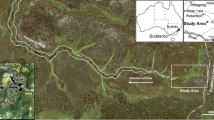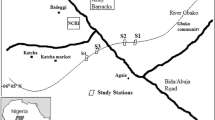Abstract
Invertebrates from eskers situated in bedrock areas were extracted from the groundwater by sieving water pumped from monitoring wells. Water quality was determined from water samples taken concurrently. The numbers of animals were small if compared with other studies from more southern parts of Europe. The animals were concentrated in the uppermost layer close to the groundwater table, which was situated at an average depth of 4 m from the ground surface. In the uppermost layer, the total numbers exceeded 10 ind. m−3at only a few sites. The deepest occurrence of animals was at 10–12 m below the ground surface. The most abundant taxa were the harpacticoids Bryocamptus minutus and Parastenocaris phyllura followed by nematodes and the lumbriculid oligochaetes Lamprodrilus isoporus and Stylodrilus heringianus. Both lumbriculids were shrunken in size. The next most abundant taxa were Diacyclops spp., turbellarians, Moraria brevipes and larvae of chironomids. The archiannelid Troglochaetus beranecki was found at several sites. Other species found were e.g. Aeolosoma hemprichi, Bryocamptus pygmaeus, Attheyella crassa, Parastenocaris glacialis and Paracyclops fimbriatus. The abundance of animals and the number of taxa were lower when the water table was situated deeper. Anthropogenic changes increased the number of both individuals and of taxa. B. minutus had the highest number of significant correlations with the water quality variables while the electrical conductivity had the highest number of correlations with the meiofauna parameters. Diversity increased with the size of pore space. Gravel extraction seemed to increase the numbers of individuals. The species diversity was high at an artificial groundwater plant having an induced infiltration. Road de-icing did not have a severe negative influence and oxygen was not a limiting factor. Food descending from the ground surface with percolating water appears to be rapidly utilized by meiofauna.
Similar content being viewed by others
References
Botosaneanu, L. (ed.) 1986. Stygofauna Mundi. Brill, Leiden: 740 pp.
Bou, C. & R. Rouch, 1967. Un nouveau champ de reserches sur la faune aquatigue souterraine. Comptes Rendus hebdomadaires des Sciences de l'acad. des Sciences, Ser. D, 265: 369–370.
Enckell, P., 1969. Distribution and dispersal of Parastenocaridae (Copepoda) in northern Europe. Oikos 20: 493–507.
Gibert, J., 1991. Groundwater systems and their boundaries: Conceptual framework and prospects in groundwater ecology. Verh. int. Ver. Limnol. 24: 1605–1608.
Gibert, J., J. A. Danielopol & J. A. Stanford, 1994. Groundwater Ecology. Academic Press, San Diego: 571 pp.
Hakenkamp, C. C., H. M. Valett & A. J. Boulton, 1993. Perspectives on the hyporheic zone: integrating hydrology and biology. Concluding remarks. J. n. am. Benthol. Soc. 12: 94–99.
Husmann, S., 1975. The boreoalpine distribution of groundwater organisms in Europe. Verh. int. Ver. Limnol. 19: 2983–2988.
Lahermo, P., M. Ilmasti, R. Juntunen & M. Taka, 1990. The hydrogeochemical mapping of Finnish groundwater. The Geochemical Atlas of Finland, Part 1. Geological Survey of Finland. 66 pp.
Malard, F., J.-L. Reygrobellet, R. Laurent & J. Mathieu, 1997. Developments in sampling the fauna of deep water-table aquifers. Arch. Hydrobiol. 138: 401–432.
Marmonier, P., P. Vervier, J. Gibert & M. J. Dole-Olivier, 1993. Biodiversity in ground waters. Trends Ecol. Evol. 8: 392–395.
Noll, W. & H. Stammer, 1953. Die Grundwasserfauna des Untermaingebietes von Hanau bis Würzburg mit Einschluss des Spessart. Mitt. Naturwiss. Mus. der Stadt Aschaffenburg. 6. Heft der neuen Folge. Aschaffenburg: 77 pp.
Pennak, R. W., 1988. Ecology of freshwater meiofauna. In Higgins, R. P. & H. Thiel (eds), Introduction to the Study of Meiofauna. Smiths. Inst. Press, Washington D.C.: 39–60.
Pospisil, P., 1994. The groundwater fauna of a Danube aquifer in the ‘Lobau’ wetland in Vienna, Austria. In Gibert, J., D. L. Danielopol & J. A. Stanford (eds), Groundwater Ecology. Academic Press, San Diego: 347–366.
Ronneberger, D., 1975. Zur Kenntnis der Grundwasserfauna des Saale-Einzugsgebietes (Thüringen). Limnologica (Berlin) 9: 323–419.
Rush, D. B. & J. B. Ritter, 1993. An investigation of hypogean meiofauna in sediments adjacent to the north fork Little Miami River, Clark Co., Ohio. Ohio. J. Sci. 93: 47.
Särkkä, J., 1995. Profundal meiofauna in two large lakes: Influence of pollution and bathymetric differences. Arch. Hydrobiol. 132: 453–493.
Särkkä, J. & J. Mäkelä, 1998. Troglochaetus beranecki Delachaux (Polychaeta, Archiannelida) in esker groundwaters of Finland: a new class of limnic animals for Northern Europe. Hydrobiologia 379: 17–21.
Särkkä, J., L. Levonen & J. Mäkelä, 1997. Meiofauna of springs in Finland in relation to environmental factors. Hydrobiologia 347: 139–150.
Särkkä, J., L. Levonen & J. Mäkelä, 1998. Harpacticoid and cyclopoid fauna of groundwater and springs in southern Finland. J. mar. Syst. 15: 155–161.
Sarvala, J., 1986. Patterns of benthic copepod assemblages in an oligotrophic lake. Ann. zool. fenn. 23: 101–130.
Stoch, F., 1995. The ecological and historical determinants of crustacean diversity in groundwaters, or: why are there so many species? Mém. Biospéol. 22: 139–160.
Strayer, D. L., 1994. Limits to biological distributions in groundwater. In Gibert, J., D. L. Danielopol & J. A. Stanford (eds), Groundwater Ecology. Academic Press, San Diego: 287–310.
Strayer, D. L., S. E. May, P. Nielsen, W. Wollheim & S. Hausam, 1995. An endemic groundwater fauna in unglaciated eastern North America. Can. J. Zool. 73: 502–508.
Triska, F. J., V. C. Kennedy, R. J. Avanzino, G. W. Zellweger & K. E. Bencala, 1989. Retention and transport of nutrients in a thirdorder stream in northwestern California: hyporheic processes. Ecology 70: 1893–1905.
Author information
Authors and Affiliations
Corresponding author
Rights and permissions
About this article
Cite this article
Särkkä, J., Mäkelä, J. Meiofauna of esker groundwaters in Finland. Hydrobiologia 405, 25–37 (1999). https://doi.org/10.1023/A:1003710829888
Issue Date:
DOI: https://doi.org/10.1023/A:1003710829888




